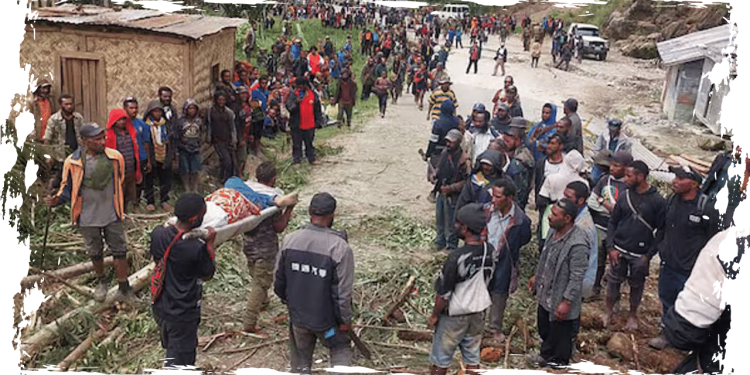The death toll from a devastating landslide in Papua New Guinea has been revised to over 670, according to the International Organization for Migration. Despite the efforts of emergency responders and the desperate search by grieving family members, any remaining hope of finding survivors has vanished.
According to Serhan Aktoprak, the head of the U.N. migration agency’s mission in the South Pacific island nation, the death toll has been revised based on new calculations. Yambali village and Enga provincial officials now believe that over 150 homes were buried in Friday’s landslide, as opposed to the previous estimate of 60 homes.
According to Aktoprak, it is estimated that currently over 670 people are buried underground.
On Sunday, rescue teams were relocating survivors to safer areas amidst the looming risks of unstable earth and ongoing tribal warfare in the Papua New Guinea Highlands.
Around 250 more houses have been deemed uninhabitable due to the ongoing ground movement caused by the landslide, resulting in approximately 1,250 individuals being displaced, according to officials.
The national government is currently contemplating whether it should formally request additional international assistance.
Rescue teams have abandoned all hope of locating survivors buried beneath layers of soil and debris, which reach depths of 6 to 8 meters (20 to 26 feet).
According to Aktoprak, there is a significant amount of grieving and mourning as people are gradually accepting and processing the situation.
According to him, the newly estimated death toll is not considered as a reliable figure as it is calculated based on the average size of families in the region per household. He refrained from making any speculations about the possibility of the actual toll being higher.
“It’s challenging to determine an exact number,” Aktoprak remarked. “We aim to maintain a realistic perspective and avoid any inflated figures.”
Government authorities have taken steps to establish evacuation centers on safer ground on both sides of the extensive debris field. The debris field, which spans an area comparable to three to four football fields, has also caused the main highway in the province to be inaccessible.
Convoys transporting food, water, and other essential supplies to the devastated village located 60 kilometers from the provincial capital, Wabag, have encountered risks associated with tribal fighting in Tambitanis village, which is located halfway along the route. The Papua New Guinea soldiers have been providing security for the convoys along the blocked highway.
Aktoprak mentioned that he didn’t anticipate tribal fighters would specifically target the convoys. However, he acknowledged that opportunistic criminals might seize the opportunity amidst the chaos to do so.
According to Aktoprak, there is a real risk of carjacking or robbery in this situation. He emphasizes that not only the safety of the personnel, but also the goods are at stake, as the chaos can be used as an opportunity for theft.
The official estimate that nearly 4,000 people were residing in the village has been called into question due to long-standing tribal conflicts. This count, which is based on data that is several years old, fails to consider those who have recently sought refuge in the village to escape ongoing clan violence, which the government has been unable to control.
Justine McMahon, the country director of the humanitarian agency CARE International, emphasized the urgent need to relocate survivors to safer areas. She also highlighted the immediate priorities of providing them with essential resources like food, water, and shelter. The military has taken charge of leading these efforts.
The authorities are still assessing the number of injured and missing individuals as of Sunday. By Saturday, seven individuals, including a child, had received medical treatment. However, officials do not have any information regarding their current conditions.
On Sunday, Defense Minister Billy Joseph and Laso Mana, the director of the National Disaster Center, took a helicopter from Port Moresby to Wabag. Their purpose was to personally assess the situation and determine the necessary measures.
The government is expected to make a decision by Tuesday on whether to officially request additional international assistance, according to Aktoprak.
The United States and Australia, as close neighbors and Papua New Guinea’s largest foreign aid provider, have publicly expressed their willingness to offer increased support to aid responders.
Papua New Guinea, a developing nation, is known for its incredible diversity, with a population of 10 million people and over 800 languages spoken. The majority of its residents are subsistence farmers, relying on agriculture for their livelihoods.










